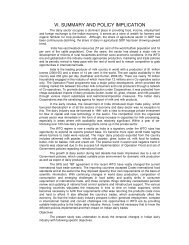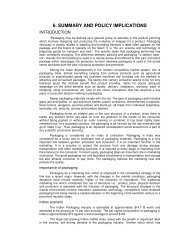economics of production and marketing of patchouli in north karnataka
economics of production and marketing of patchouli in north karnataka
economics of production and marketing of patchouli in north karnataka
You also want an ePaper? Increase the reach of your titles
YUMPU automatically turns print PDFs into web optimized ePapers that Google loves.
VI. SUMMARY AND POLICY IMPLICATIONS<br />
Agriculture is the ma<strong>in</strong>stay <strong>of</strong> the Indian economy contribut<strong>in</strong>g 22.1 per cent to the<br />
GDP (2003-04). With the liberalization <strong>of</strong> Indian economy <strong>in</strong> 1991, there has been a<br />
considerable <strong>in</strong>crease <strong>in</strong> the <strong>in</strong>tegration with the global economy. The share <strong>of</strong> agricultural<br />
exports <strong>in</strong> the country’s total export is fast reduc<strong>in</strong>g. At present, it accounts for about 11 per<br />
cent. With a view to improve the share <strong>of</strong> agricultural exports <strong>in</strong> the country emphasis on<br />
diversification <strong>of</strong> agriculture <strong>in</strong>to high value commercial <strong>and</strong> exportable crops is necessary.<br />
Agricultural exports are contribut<strong>in</strong>g around 12.26 per cent to India’s total export earn<strong>in</strong>gs<br />
(2003-04) <strong>and</strong> also play a significant role <strong>in</strong> employment generation, particularly <strong>in</strong> the rural<br />
sector. The New Agricultural Policy, therefore, emphasizes diversification <strong>of</strong> agriculture.<br />
The commercial cultivation <strong>of</strong> <strong>patchouli</strong> is <strong>of</strong> recent orig<strong>in</strong> <strong>in</strong> India. It is slowly<br />
spread<strong>in</strong>g <strong>in</strong> the states <strong>of</strong> Karnataka, Gujarat, Assam, Andhra Pradesh <strong>and</strong> Kerala etc.<br />
Karnataka is lead<strong>in</strong>g <strong>in</strong> the <strong>production</strong> <strong>of</strong> <strong>patchouli</strong>. In Northern Karnataka, the area is<br />
spread<strong>in</strong>g faster than ever before. The districts <strong>of</strong> Uttar Kannada, Haveri, Dharwad, Belgaum<br />
<strong>and</strong> Bellary have recorded higher acreage. (Venugopal et al., 2004). Presently, the crop<br />
covers an estimated area <strong>of</strong> 200 acres <strong>in</strong> <strong>north</strong>ern districts <strong>of</strong> Karnataka (Venugopal et al.,<br />
2004).<br />
North Karnataka is blessed with diverse agro-climatic conditions <strong>in</strong> districts like Uttar<br />
Kannada, Haveri, Belgaum, Dharwad which provides optimum grow<strong>in</strong>g conditions for<br />
<strong>patchouli</strong>. Warm <strong>and</strong> humid places with fairly heavy <strong>and</strong> even distribution <strong>of</strong> ra<strong>in</strong>fall are<br />
required for <strong>patchouli</strong> cultivars. The districts <strong>of</strong> Uttar Kannada <strong>and</strong> Haveri have the humid<br />
climate with good ra<strong>in</strong>fall distribution, suitable for cultivation <strong>of</strong> <strong>patchouli</strong>.<br />
Indian dem<strong>and</strong> for <strong>patchouli</strong> oil is around 220 tonnes valued at around Rs. 33 crores<br />
(Vijaykumar, 2004). But, current <strong>production</strong> <strong>of</strong> <strong>patchouli</strong> oil is hardly a few hundred kilograms<br />
<strong>and</strong> that too quality variation is very large (Farooqi et al., 2000). Inspite <strong>of</strong> farmers enthusiasm<br />
to cultivate <strong>patchouli</strong>, <strong>in</strong>adequate supply <strong>of</strong> genu<strong>in</strong>e plant<strong>in</strong>g material on large scale at<br />
reasonable price, lack <strong>of</strong> market <strong>in</strong>formation <strong>and</strong> <strong>in</strong>ability to <strong>in</strong>crease the yield potentiality due<br />
to lack <strong>of</strong> advanced technology are a few setbacks to mention. Therefore, there is a need to<br />
reorient the <strong>production</strong> <strong>and</strong> <strong>market<strong>in</strong>g</strong> structure. Hence, a comprehensive study on <strong>production</strong><br />
<strong>and</strong> <strong>market<strong>in</strong>g</strong> <strong>of</strong> <strong>patchouli</strong> has become imperative. Therefore, the study was undertaken with<br />
the follow<strong>in</strong>g specific objectives.<br />
1. To study the feasibility <strong>of</strong> <strong>in</strong>vestment <strong>in</strong> Patchouli cultivation<br />
2. To analyse the cost <strong>and</strong> returns <strong>in</strong> Patchouli cultivation<br />
3. To study different <strong>market<strong>in</strong>g</strong> channels used by the Patchouli cultivators<br />
4. To ascerta<strong>in</strong> constra<strong>in</strong>ts <strong>in</strong> <strong>production</strong> <strong>and</strong> <strong>market<strong>in</strong>g</strong> <strong>of</strong> Patchouli cultivation<br />
METHODOLOGY<br />
North Canara <strong>and</strong> Haveri districts were purposively selected for the study, as these<br />
districts have highest area under <strong>patchouli</strong> crop <strong>in</strong> the state. Sirsi, Siddapur <strong>and</strong> Yellapur<br />
taluks <strong>in</strong> North Canara <strong>and</strong> Hangal, Hirekerur <strong>and</strong> Byadagi taluks <strong>in</strong> Haveri districts were<br />
purposively selected because <strong>patchouli</strong> crop was almost entirely concentrated <strong>in</strong> these taluks.<br />
Primary data was collected with the aid <strong>of</strong> well structured <strong>and</strong> comprehensive schedule<br />
exclusively prepared for the study.<br />
Tabular analysis was employed for determ<strong>in</strong><strong>in</strong>g the costs <strong>and</strong> returns <strong>of</strong> <strong>production</strong> as<br />
well as <strong>market<strong>in</strong>g</strong> <strong>of</strong> <strong>patchouli</strong>. St<strong>and</strong>ard f<strong>in</strong>ancial feasibility evaluation techniques viz., NPV,<br />
IRR, PBP <strong>and</strong> BCR were used to f<strong>in</strong>d out the economic viability <strong>of</strong> <strong>in</strong>vestment <strong>in</strong> <strong>patchouli</strong><br />
farms.<br />
F<strong>in</strong>d<strong>in</strong>gs <strong>of</strong> the study<br />
1. General characteristics <strong>of</strong> the farmers <strong>in</strong> the study area revealed that all the farmers were<br />
literatres <strong>and</strong> average area under the <strong>patchouli</strong> crop was 0.95 ha (45.02% <strong>of</strong> total l<strong>and</strong>
hold<strong>in</strong>g) <strong>and</strong> 0.47 ha (9.77% <strong>of</strong> total l<strong>and</strong> hold<strong>in</strong>g) per farmer <strong>in</strong> North Canara <strong>and</strong> Haveri<br />
districts, respectively.<br />
2. Per hectare establishment cost was Rs. 81236.95 <strong>and</strong> Rs. 80087.66 <strong>in</strong> North Canara <strong>and</strong><br />
Haveri districts, respectively per ha per year. Ma<strong>in</strong>tenance cost <strong>of</strong> <strong>patchouli</strong> gardens was<br />
Rs. 74366.91 <strong>and</strong> Rs. 71907.73 <strong>in</strong> North Canara <strong>and</strong> Haveri districts, respectively.<br />
3. Average total yield <strong>of</strong> <strong>patchouli</strong> garden was 24918.12 kgs <strong>and</strong> 24238.05 kgs <strong>in</strong> North<br />
Canara <strong>and</strong> Haveri district, respectively <strong>and</strong> the correspond<strong>in</strong>g gross returns were Rs.<br />
487647.56 <strong>and</strong> Rs. 468764.01 <strong>in</strong> North Canara <strong>and</strong> Haveri district, respectively.<br />
4. The results <strong>of</strong> the f<strong>in</strong>ancial feasibility study <strong>in</strong>dicated that per ha NPV for entire life period<br />
<strong>of</strong> <strong>patchouli</strong> garden (3 years) was found to be Rs. 156975.27 <strong>and</strong> Rs. 148407.19 <strong>in</strong> North<br />
Canara <strong>and</strong> Haveri districts, respectively. B:C ratio at 9.5 per cent discount rate was 2.45<br />
<strong>in</strong> North Canara district <strong>and</strong> 2.44 <strong>in</strong> Haveri district. Payback period was 0.28 years <strong>in</strong><br />
North Canara districts <strong>and</strong> 0.29 years <strong>in</strong> Haveri districts <strong>and</strong> <strong>in</strong>ternal rate <strong>of</strong> return was<br />
88.93 <strong>and</strong> 87.30 per cent <strong>in</strong> North Canara <strong>and</strong> Haveri districts, respectively.<br />
5. Producers preference for different <strong>market<strong>in</strong>g</strong> channels were assessed <strong>and</strong> five channels<br />
were identified <strong>in</strong> the study area.<br />
a. In the first channel, farmer took the produce to the local processor. This channel was<br />
followed by 16.67 per cent <strong>of</strong> the farmers <strong>in</strong> North Canara <strong>and</strong> was not followed by the<br />
farmers <strong>of</strong> Haveri. In second channel, local processor had buyback arrangement with the<br />
farmers, which was only oral arrangement. This channel was followed by 43.33 per cent <strong>of</strong><br />
North Canara <strong>and</strong> 23.33 per cent <strong>of</strong> Haveri district farmers. In third channels also, there<br />
was buyback arrangement but with big aromatic crops process<strong>in</strong>g company, 10 per cent<br />
<strong>and</strong> 23.33 per cent <strong>of</strong> the farmers <strong>of</strong> North Canara <strong>and</strong> Haveri district sold their produce.<br />
Fourth channel is the only channel with market <strong>in</strong>termediary, 23.33 per cent <strong>and</strong> 53.34 per<br />
cent <strong>of</strong> the farmers <strong>of</strong> North Canara <strong>and</strong> Haveri district sold their produce through this<br />
channel. In fifth channel, farmer himself distilled the <strong>patchouli</strong> herbage <strong>and</strong> he sold the oil<br />
to local factors. This channel was followed by 6.67 per cent <strong>of</strong> North Canara district<br />
farmers <strong>and</strong> absent <strong>in</strong> Haveri district.<br />
6. Market<strong>in</strong>g cost <strong>in</strong>curred by <strong>patchouli</strong> growers <strong>in</strong> channel-I, channel-II, channel-III,<br />
channel-IV <strong>and</strong> channel-V was Rs. 538.18, Rs. 106.56, Rs. 106.56, Rs. 106.56 <strong>and</strong> Rs.<br />
3123.67 <strong>in</strong> North Canara district, respectively. It was Rs. 94.72 when the producer sold<br />
the produce through channel-II (or) channel-III (or) channel IV <strong>in</strong> Haveri district, because<br />
load<strong>in</strong>g cost was the only cost <strong>in</strong>curred by the producer. Channel-I <strong>and</strong> channel-V were<br />
none <strong>in</strong> Haveri district.<br />
7. Market<strong>in</strong>g cost <strong>in</strong>curred by the agents <strong>of</strong> the company (<strong>in</strong>termediary) was Rs. 544.85 <strong>and</strong><br />
Rs. 504.73 <strong>in</strong> North Canara district <strong>and</strong> Haveri district, respectively <strong>and</strong> the <strong>market<strong>in</strong>g</strong><br />
marg<strong>in</strong> was Rs. 548.59 <strong>and</strong> Rs. 673.60 <strong>in</strong> North Canara <strong>and</strong> Haveri districts, respectively.<br />
8. Price received by the farmers <strong>of</strong> North Canara district when they sold their produce<br />
through channel-I, channel-II, channel-III, channel-IV <strong>and</strong> channel-V was Rs. 20200.00,<br />
Rs. 20000.00, Rs. 20000.00, Rs. 19156.56 <strong>and</strong> Rs. 37500.00, respectively. The<br />
correspond<strong>in</strong>g net price received was Rs. 19664.82, Rs. 19893.44, Rs. 19893.44, Rs.<br />
19049.44 <strong>and</strong> Rs. 34376.33. The price received by the farmer <strong>in</strong> channel-V was highest<br />
because he distilled the <strong>patchouli</strong> herbage <strong>and</strong> the lowest price was received by farmer<br />
who sold produce to the agents <strong>of</strong> the company. Similarly, <strong>in</strong> Haveri district, price<br />
received by the farmers when the produce was sold through channel-II, channel-III <strong>and</strong><br />
channel-IV was Rs. 20000.00, Rs. 20000.00 <strong>and</strong> Rs. 19071.67, respectively. The<br />
correspond<strong>in</strong>g net price received was Rs. 19905.28, Rs. 19905.28 <strong>and</strong> Rs. 18976.96,<br />
respectively. Here also, the farmer received least price when he sold the produce to<br />
agents <strong>of</strong> the company.<br />
9. Major problems faced by the farmers <strong>in</strong> the <strong>production</strong> <strong>of</strong> <strong>patchouli</strong> were water logg<strong>in</strong>g<br />
<strong>in</strong> ra<strong>in</strong>y season, frequent irrigation <strong>and</strong> nematode attack expressed by 100, 100 <strong>and</strong> 70<br />
per cent <strong>of</strong> North Canara district farmers <strong>and</strong> 100, 90 <strong>and</strong> 90 per cent <strong>of</strong> the farmers <strong>of</strong><br />
Haveri district, respectively. Other problems were post-harvest dry<strong>in</strong>g, need <strong>of</strong> well
dra<strong>in</strong>ed soil to grow the crop <strong>in</strong>festation <strong>of</strong> plants with wilt caused by fungus, lack <strong>of</strong><br />
proper package <strong>of</strong> practice, need <strong>of</strong> technical assistance <strong>and</strong> leaf blight.<br />
10. Three problems were expressed by the farmers <strong>in</strong> the <strong>market<strong>in</strong>g</strong> <strong>of</strong> <strong>patchouli</strong>. They<br />
were non-availability <strong>of</strong> method/<strong>in</strong>strument to assess the quality <strong>of</strong> <strong>patchouli</strong> herbage at<br />
farm level expressed by 83.33 <strong>and</strong> 96.67 per cent <strong>of</strong> the farmers, <strong>of</strong> North Canara <strong>and</strong><br />
Haveri district, respectively. Secondly, cheat<strong>in</strong>g the farmers by the agents <strong>of</strong> the<br />
company expressed by 15 per cent <strong>and</strong> 25 per cent farmers <strong>of</strong> North Canara <strong>and</strong><br />
Haveri district, respectively. Third was lack <strong>of</strong> market <strong>in</strong>formation expressed by 63.33<br />
per cent <strong>and</strong> 80.00 per cent <strong>of</strong> North Canara <strong>and</strong> Haveri farmers, respectively.<br />
POLICY IMPLICATIONS<br />
1. Investment <strong>in</strong> <strong>patchouli</strong> gardens were found to be economically sound <strong>and</strong> f<strong>in</strong>ancially<br />
feasible, farmers should be encouraged to take up the cultivation <strong>of</strong> the crop on large<br />
scale. This will reduce the imports <strong>and</strong> also helps to take advantage <strong>in</strong> <strong>in</strong>ternational<br />
market by export<strong>in</strong>g, especially under the trade liberalization regime.<br />
2. Inspite <strong>of</strong> farmers enthusiasm to cultivate <strong>patchouli</strong>, <strong>in</strong>adequate supply <strong>of</strong> genu<strong>in</strong>e<br />
plant<strong>in</strong>g material on large scale at reasonable price was the ma<strong>in</strong> limitation for the<br />
farmers to take up <strong>patchouli</strong> cultivation on large scale <strong>and</strong> it was also the ma<strong>in</strong> limitation<br />
to establish new <strong>patchouli</strong> garden. Therefore, genu<strong>in</strong>e plant<strong>in</strong>g material should be made<br />
available to the farmer through the Department <strong>of</strong> Horticulture or Research Institutes.<br />
3. Net returns obta<strong>in</strong>ed after process<strong>in</strong>g (steam distillation) was double composed to<br />
unprocessed. Therefore, the farmers should be encouraged to take up process<strong>in</strong>g by<br />
themselves by giv<strong>in</strong>g subsidy <strong>and</strong>/or loan for establish<strong>in</strong>g the steam distillation unit.<br />
4. Lack <strong>of</strong> technical guidance <strong>and</strong> package <strong>of</strong> practice was expressed by the farmers.<br />
Therefore, there is a great need for extension activities by the subject matter specialists <strong>in</strong><br />
SAU’s, KVK’s (or) NGO volunteers to develop st<strong>and</strong>ard package <strong>of</strong> practice.<br />
5. All <strong>patchouli</strong> grow<strong>in</strong>g farmers should come together <strong>and</strong> from co-operatives by which they<br />
can discuss <strong>and</strong> solve their problem (e.g., Distillat<strong>in</strong>g the <strong>patchouli</strong> herbage on cooperative<br />
basis, which gives high pr<strong>of</strong>it).<br />
6. In the study area, there was no contract farm<strong>in</strong>g. S<strong>in</strong>ce, <strong>patchouli</strong> is an aromatic plant <strong>of</strong><br />
recent orig<strong>in</strong> not much is known to the farmers about <strong>production</strong> (or) <strong>market<strong>in</strong>g</strong>, there is a<br />
great need for contract farm<strong>in</strong>g, because contract farm<strong>in</strong>g will solve most <strong>of</strong> the prevail<strong>in</strong>g<br />
<strong>production</strong> <strong>and</strong> <strong>market<strong>in</strong>g</strong> problems i.e., genu<strong>in</strong>e plant<strong>in</strong>g material, technical guidance,<br />
market <strong>in</strong>formation, cheat<strong>in</strong>g <strong>of</strong> farmers by middlemen.<br />
7. Price <strong>of</strong> <strong>patchouli</strong> was largely quality based. Therefore, there is a great need to create<br />
test<strong>in</strong>g facility at procurement levels. Further, lack <strong>of</strong> test<strong>in</strong>g facility at procurement stage<br />
was expressed as a problem by majority <strong>of</strong> farmers.

















